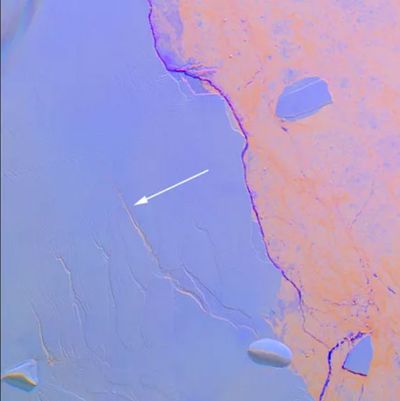
In 1978, the renowned geologist John H. Mercer published a paper that doubled as an apocalyptic warning. In his studies of Antarctica, Mercer had concluded that the western part of the ice continent was profoundly vulnerable to human-induced climate change — so vulnerable, it posed a “threat of disaster” from rising seas. He predicted that the first sign of this cataclysm would come when ice shelves began breaking off the peninsula, with the first separations coming at its northern tip and then moving progressively southward.
In 1995, the ice shelf at the northern tip of that peninsula, known as Larsen A, began breaking up. In 2002, the next ice shelf down, Larsen B, partially collapsed.
And this week, a Delware-sized, trillion-ton chunk of Larsen C broke off Antarctica, producing one of the largest icebergs ever recorded. The development represents such a fundamental change in Antarctica’s geography that maps of the continent will need to be rewritten.
The chunk of Larsen C that broke off Antarctica split at an alarming rate.
There’s reason to think this development is less ominous than it may sound. But there is also reason to view it as a fulfillment of Mercer’s dark prophecy.
Let’s start with the good news: Larsen C was already floating before it was separated, and so its breaking off will have no immediate impact on sea levels. It’s true that the worry with ice shelves is generally about delayed impact: These masses of ice act as corks keeping Antartica’s glaciers bottled up on land. Remove the ice shelves, and those glaciers will flow out to sea, and raise sea levels. But Larsen A, B, and C, were all holding back relatively little land ice.
It’s far from certain that this week’s splitting off will result in the total collapse of Larsen C, as some scientists believe it could still regrow. But even if it does, it’s not going to have a calamitous impact on sea levels, in and of itself.
What’s more, it’s far from clear that this event is primarily the product of climate change. Icebergs have been breaking off of ice shelves for millions of years. Scientists broadly accept that climate change played a role in the disintegration of Larsen A and B. But natural variability may be sufficient to explain the mere splitting off of a large chunk of Larsen C. Adrian Luckman, professor of glaciology at Swansea University, told The Guardian that recent data suggests most of the shelf’s ice has actually been thickening.
As for the bad news: Some scientists maintain the climate change played a role. And remember, in Mercer’s prophecy, Larsen C is the canary in the coal mine. While its demise is not, by itself, a catastrophe, it could portend one. In other parts of Antarctica, similar ice shelves are holding back enormous glaciers. Were they to collapse, uncorked land ice could move (relatively) rapidly toward the ocean, raising sea levels by many feet (the collapse of the entire Western Antarctic Ice Sheet, alone, could raise sea levels by ten feet). How imminently such a scenario could come to pass is unclear.
Finally, while there is disagreement among scientists about climate change’s role in Larsen C’s breaking off, there is little doubt that unchecked manmade warming will, eventually, pose a significant threat to the continent’s ice shelves — and, thus, to the world’s coastal cities.






























